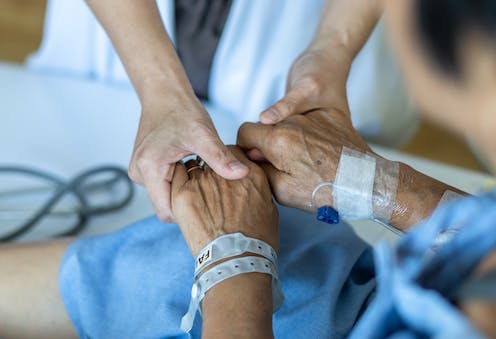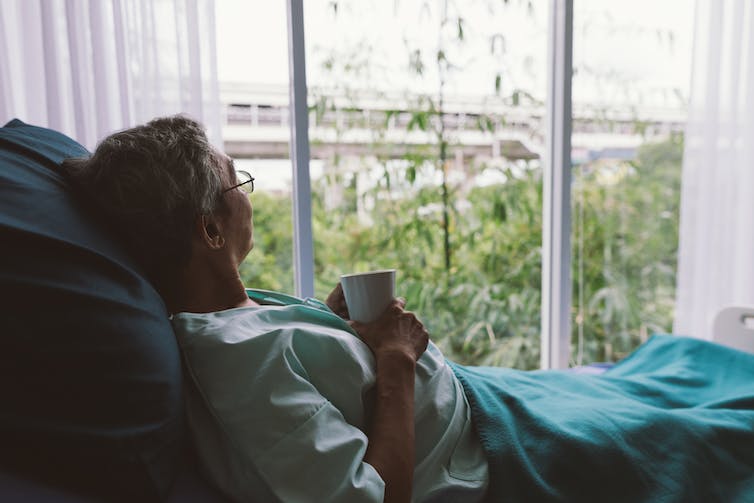
Most people may not wish to devote much time to thinking about their death. However, it’s an unfortunate fact that the entry point into experiences or conversations around death and end-of-life care can happen abruptly.
An unexpected death or a terminal diagnosis can leave people ill-equipped to navigate what often feels like uncharted territory of navigating end-of-life care, bereavement and grief.
The challenging realities surrounding end-of-life care are especially difficult for older people experiencing homelessness. For these older adults, intersectional and compounding experiences of oppression, such as poverty, racial disparities and ageism, create barriers to accessing hospice care.
Table of Contents
Misconceptions about hospice care
The need for end-of-life and palliative services for unhoused people will likely continue to grow as the population experiencing homelessness grows and ages.
Currently only 16 to 30 per cent of Canadians have access to hospice and palliative care services, and 34 per cent of Canadians are not clear on who is eligible or who should utilize hospice services. In response, May 7-13 marks National Hospice Palliative Care week, which is aimed at increasing awareness about hospice care in Canada.

(Shutterstock)
The misconceptions about hospice care have had a direct impact on the engagement of services for the public, but also for Indigenous communities and for older adults experiencing homelessness.
Efforts to increase awareness about hospice often neglect the most vulnerable populations. Future efforts must merge education and awareness with intersectionality, which takes into consideration the intersections of inequities that impact unhoused older adults.
Hospice care focuses on addressing the full spectrum of a patient’s physical, emotional, social and spiritual experiences and needs. A common misconception is that hospice is exclusively a location or place where people go to die. Contrary to this notion, hospice is a service that is provided in various settings including within one’s home, long-term care facilities, hospice centres or within a hospital.
End-of-life care
While many Canadians prefer to die at home, older people experiencing homelessness do not have the same opportunities for end-of-life care options, and as a result many unhoused older people die in the hospital or institutional settings.
Family and friends often play an essential role in caring and advocating for a loved one during their end-of-life process. We can only hope to have loved ones by our side during these final stages; however, that is not the reality for many unhoused community members who do not have the option to die at home with loved ones.
Older people experiencing homelessness are especially vulnerable due to limited family or social support networks. Lack of social support can result in unhoused older people feeling isolated and fearful about dying alone or anonymously.
A core focus of palliative care is on easing symptoms and increasing quality of life for people who have a serious or chronic illness, and not solely for those who are dying. Palliative care can be a valuable form of health care for older people experiencing homelessness, as it can offer a tailored approach to managing multiple chronic or terminal illnesses, which are prevalent among unhoused older people.
Palliative care that takes place in a hospital setting can decrease end-of-life care costs by nearly 50 per cent by reducing intensive care unit admissions and unnecessary intervention procedures.
We believe it is valuable to consider that if end-of-life care costs were reduced by using palliative care practices, the cost savings could be used to fund services that directly support unhoused older adults, such as increased affordable housing options.
Aging in the right place
As members of the Aging in the Right Place project research team at Simon Fraser University, we are working to better understand what aging and dying in the right place means to unhoused older adults in two sites providing end-of-life care in Vancouver.
May’s Place Hospice, which is in the Downtown Eastside of Vancouver, provides end-of-life care for community members in that part of the city. May’s Place has created a communal, home-like environment with private rooms, meals provided three times a day, 24-hour nursing care, a smoking lounge and family gathering space.

(Shutterstock)
Another inpatient hospice setting in Vancouver is Cottage Hospice, located in a 1924 heritage building. Patients have a view of the North Shore mountains and are close to the water. Cottage Hospice and May’s place provide the same types of hospice palliative care support, and both care for older patients experiencing homelessness, but serve different populations based on their location and setting, demonstrating that hospice and palliative care is not a one-size-fits all approach.
The Aging in the Right Place project captures the perspectives and lived experiences of older people experiencing homelessness through integrating photovoice interview research methods as well as data collection methods that focused on the hospice setting, the neighbourhood, and experiences of staff who work to support unhoused older people. Photovoice is a method used in community-based research in which participants use photo taking and storytelling to document their own perspectives and experiences.
Within British Columbia — also known as the land that belongs to the Skwxwú7mesh (Squamish), xʷməθkwəy̓əm (Musqueam) and Səl̓ílwətaʔ/Selilwitulh (Tsleil-Waututh) people — colonization and colonial medical models have had lasting and detrimental impacts on Indigenous knowledge and traditional practices around death and dying for First Nation communities.
One example of these impacts is that current hospice models may not reflect culturally relevant care models. Hospice organizations throughout B.C. should prioritize increasing policy and practice for Indigenous groups to ensure safety and culturally relevant care are implemented. Ensuring accessibility to hospice and palliative care is one step towards dismantling these barriers for Indigenous populations.
B.C. can turn to the Palliative Education and Care for the Homeless (PEACH) service fostered by Inner City Health Associates (ICHA) in Toronto as an example. PEACH is taking a diverse and innovative approach to providing palliative care among the homeless and vulnerable populations, including Indigenous communities and older adults. Innovative and culturally sensitive services such as these, are a step in the right direction to providing better end-of-life care to older adults experiencing homelessness.
It is crucial that we make hospice and palliative care services available to all community members, especially with the aging population and an increase in chronic illnesses throughout Canada.
In addition to supporting community members, hospice and palliative care should focus efforts on tailoring approaches to provide culturally relevant care, increasing staff education about the lived experiences of older people experiencing homelessness, and creating safe and accessible services in B.C. for marginalized communities.
We must actively dismantle misconceptions about the role of hospice and palliative care through education and awareness to facilitate appropriate service delivery and use for diverse populations.
![]()
Rachelle Patille receives funding Canada Mortgage and Housing Corporation (CMHC) and the Social Sciences and Humanities Research Council (SSHRC) in affiliation with the AIRP Project which this piece is linked to.
Atiya Mahmood receives funding from Canada Mortgage and Housing Corporation (CMHC) and the Social Sciences and Humanities Research Council (SSHRC) for the AIRP project which this piece is linked to.
Gracen Bookmyer receives funding Canada Mortgage and Housing Corporation (CMHC) and the Social Sciences and Humanities Research Council (SSHRC) in affiliation with the AIRP Project which this piece is linked to.
Sarah Canham receives funding from the Canada Mortgage and Housing Corporation (CMHC) and the Social Sciences and Humanities Research Council (SSHRC) in affiliation with the AIRP Project which this piece is linked to.






















